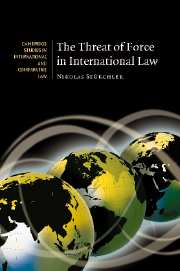Book contents
- Frontmatter
- Contents
- Foreword
- Preface
- List of abbreviations
- 1 Birth and infancy of a Charter rule: the open framework
- 2 The menu of choice: a guide to interpretation
- 3 Precedents of the international court of justice
- 4 Deciphering post-Charter practice: means and limits
- 5 Open threats to extract concessions
- 6 Demonstrations of force
- 7 Countervailing threats or: threats in self-defence
- 8 Findings and conclusions
- 9 Epilogue: the law in operation
- Annex
- Bibliography
- Index
- CAMBRIDGE STUDIES IN INTERNATIONAL AND COMPARATIVE LAW
4 - Deciphering post-Charter practice: means and limits
Published online by Cambridge University Press: 04 July 2009
- Frontmatter
- Contents
- Foreword
- Preface
- List of abbreviations
- 1 Birth and infancy of a Charter rule: the open framework
- 2 The menu of choice: a guide to interpretation
- 3 Precedents of the international court of justice
- 4 Deciphering post-Charter practice: means and limits
- 5 Open threats to extract concessions
- 6 Demonstrations of force
- 7 Countervailing threats or: threats in self-defence
- 8 Findings and conclusions
- 9 Epilogue: the law in operation
- Annex
- Bibliography
- Index
- CAMBRIDGE STUDIES IN INTERNATIONAL AND COMPARATIVE LAW
Summary
It is better to be approximately right than exactly wrong.
John TukeyExpanding the search
The previous chapters have examined historical pedigree, systemic context and case law only to arrive at the conclusion that the legal regime governing threats of force still eludes rigid legal taxonomy. The UN Charter does not define the phrase ‘threat of force’. Within the broad parameters of the drafter's intent, it remains unclear what degree of intensity or what specific conduct would violate article 2(4) or would exceptionally appear lawful under article 51. To read the travaux is to become aware of the lack – not presence – of concrete consent. Subsequent agreements and resolutions affirm but, unhelpfully, merely repeat the Charter text. The ICJ provides very limited and at times contradictory guidance. So far, however, we have not explored the question of whether UN members, who now number four times as many as in 1945, have learned to read article 2(4) differently in their sixty years of practice.
In short, the need arises to employ state practice to narrow the margins of uncertainty; to ascertain whether mobilisations of the military are permissible; which hostile promises are unjustifiable; and which responses, if any, to counter military threats are acceptable. ‘The UN Charter’, the ICJ explained in 1986, ‘by no means covers the whole area of the regulation of force in international relations’.
- Type
- Chapter
- Information
- The Threat of Force in International Law , pp. 92 - 126Publisher: Cambridge University PressPrint publication year: 2007

